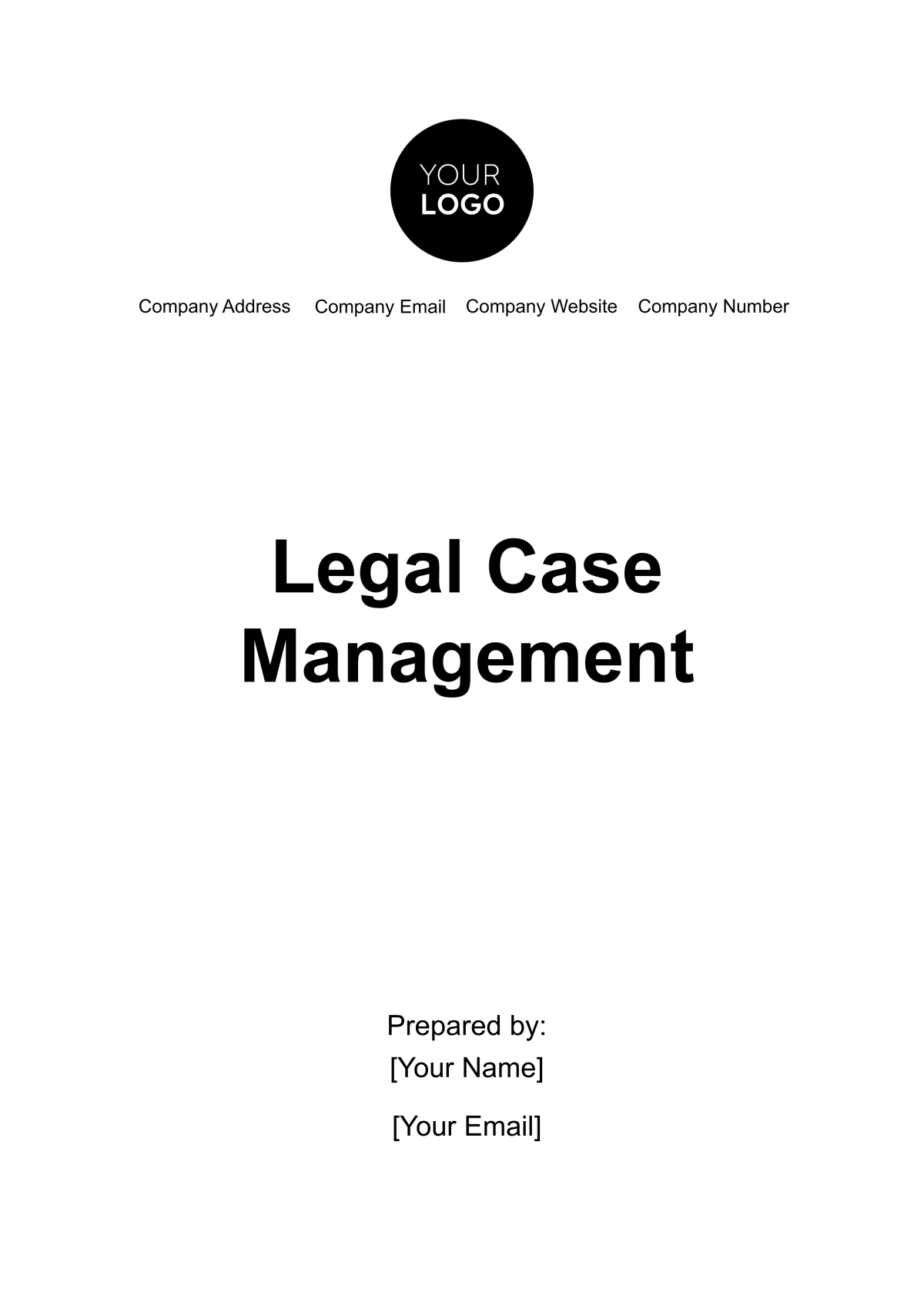Marketing Document on Legal Considerations for Product Launch
Introduction
Launching a new product is an exciting venture for any company, but it's crucial to navigate the legal landscape comprehensively to ensure a smooth and compliant product launch. This document outlines the key legal considerations and precautions necessary to protect [Your Company Name] and ensure a successful product launch.
Intellectual Property Rights
Trademark and Branding
Trademark Registration: It's essential to register any new trademarks associated with the product name, logo, or packaging design to protect our brand identity.
Infringement Checks: Conduct thorough trademark searches not only to ensure our branding does not infringe upon existing trademarks but also to identify potential opportunities to register new trademarks.
Brand Guidelines: Establish clear brand guidelines that encompass not only visual elements like logos and color schemes but also brand messaging and tonality to maintain consistency in branding across all marketing materials and product packaging.
Brand Enforcement: Develop a strategy for enforcing our trademark rights, including monitoring the market for potential trademark infringements and taking appropriate legal action when necessary.
Patents and Innovation
Patent Protection: If the product includes innovative technology or features, consider patent protection to prevent competitors from copying our designs. This protection can extend to the product's unique features, manufacturing processes, or any groundbreaking technology integrated into the product.
Patent Searches: Conduct comprehensive patent searches not only to ensure our product does not infringe on existing patents but also to identify potential areas where we can innovate and secure patents.
Intellectual Property Portfolio Management: Create a systematic approach to managing our intellectual property portfolio, including patents, copyrights, trade secrets, and domain names, to maximize protection and maintain a competitive advantage.
Regulatory Compliance
Product Testing: Ensure the product undergoes all necessary safety and quality testing to meet not only industry standards but also specific regulatory requirements in the regions where the product will be sold.
Compliance Certificates: Obtain any required compliance certificates or approvals from regulatory authorities, and establish a process for regularly updating these certificates as regulations evolve.
Product Labeling: Pay meticulous attention to product labeling, ensuring that it includes all required information, such as ingredients, safety warnings, and usage instructions, in compliance with regional regulations.
Environmental Regulations
Environmental Impact Assessment: If the product has environmental implications, conduct a comprehensive environmental impact assessment, considering factors like raw material sourcing, manufacturing processes, and end-of-life disposal. Adhere to all relevant environmental regulations and certifications, such as ISO 14001.
Eco-Friendly Claims: If the product is marketed as eco-friendly or sustainable, ensure that these claims are accurate, substantiated, and in compliance with guidelines set forth by relevant regulatory bodies, such as the Federal Trade Commission (FTC).
Supply Chain Sustainability: Assess the sustainability of your entire supply chain, from sourcing materials to manufacturing and transportation, to ensure alignment with environmental regulations and corporate sustainability goals.
Export Control and International Regulations
Export Compliance: Explain how the product launch complies with export control laws, including licensing requirements for international sales.
International Regulations: Discuss any specific regulatory requirements in international markets where the product will be distributed.
Consumer Protection and Warranty
Consumer Rights: Outline how the product launch aligns with consumer protection laws and regulations, emphasizing fair pricing, warranties, and return policies.
Warranty Terms: If applicable, detail the product warranty terms and how they comply with legal standards, such as the Magnuson-Moss Warranty Act.
Advertising and Marketing Compliance
Truth in Advertising: Discuss adherence to truth-in-advertising laws, including avoiding false or misleading claims in marketing materials.
Endorsement Guidelines: If using endorsements or testimonials, explain how these comply with Federal Trade Commission (FTC) guidelines.
Contractual Agreements
Supplier Agreements: Establish clear supplier contracts that not only outline product specifications, quality standards, and delivery terms but also include clauses addressing ownership of intellectual property, confidentiality, non-compete agreements, and dispute resolution mechanisms.
Supplier Audits: Conduct regular supplier audits to verify compliance with the terms of supplier agreements and to ensure that suppliers are meeting quality and safety standards.
Distribution and Retail Agreements
Distribution Agreements: Ensure distribution agreements clearly define responsibilities, pricing, geographic territories, and exclusivity arrangements, if applicable.
Retail Contracts: Establish comprehensive contracts with retailers that address pricing structures, payment terms, return policies, marketing and promotional strategies, and any co-branding initiatives.
Customer Data Protection
Data Collection: If the product involves collecting customer data, ensure compliance with data privacy laws, such as GDPR or CCPA. Conduct a Data Protection Impact Assessment (DPIA) to identify and mitigate privacy risks.
Privacy Policies: Develop and publish transparent privacy policies that inform customers about data collection, usage, protection practices, and their rights concerning their data.
Data Retention and Deletion: Establish data retention and deletion policies, specifying the duration for which customer data will be retained and the procedures for securely deleting data when it's no longer needed.
Data Breach Response Plan: Develop a robust data breach response plan that outlines steps to be taken in the event of a data breach, including notification procedures as required by law.
Cybersecurity
Data Security Measures: Implement and continuously update robust cybersecurity measures to protect customer data from breaches or cyberattacks. This includes measures like encryption, regular vulnerability assessments, and intrusion detection systems.
Employee Training: Conduct regular cybersecurity training for employees to raise awareness about potential threats, safe online practices, and the importance of data security.
Incident Response Plan: Develop and periodically test an incident response plan to address data breaches promptly and effectively while remaining in compliance with legal requirements.
Liability and Insurance
Insurance Coverage: It's crucial to obtain comprehensive product liability insurance to protect against potential claims or lawsuits related to product defects or harm caused by product usage. Periodically review and update the coverage to ensure it adequately covers the product and its associated risks.
Risk Mitigation Strategies: Develop and implement risk mitigation strategies that not only minimize the likelihood of product-related incidents but also demonstrate our commitment to safety and responsibility.
Legal Counsel: Consult with legal counsel experienced in product liability matters to ensure our insurance coverage aligns with our specific product and industry.
Communication Procedures Between Parties
Clear and effective communication between parties involved in the product launch is paramount to ensure that legal considerations are addressed promptly and accurately. This section outlines the communication procedures to be followed between [Your Company Name] and relevant external parties, such as suppliers, legal counsel, regulatory authorities, and distributors.
Supplier Communication
Regular Updates: Maintain regular communication with suppliers to stay informed about product development, quality control, and production schedules.
Intellectual Property Discussion: Engage in discussions with suppliers regarding the protection of intellectual property, ensuring that they understand and comply with our trademark, patent, and confidentiality requirements.
Legal Review: Collaborate with legal counsel to review supplier contracts, making certain that all contractual terms are understood and agreed upon.
Legal Counsel Collaboration
Consultation: Maintain an open line of communication with our legal counsel throughout the product launch process to address legal questions, concerns, or issues promptly.
Regulatory Updates: Legal counsel should keep the company informed about changes in laws or regulations that may affect the product launch.
Documentation: Ensure that all legal discussions and advice are documented for reference and compliance purposes.
Regulatory Authorities Interaction
Submission and Review: Submit all required documents and applications to regulatory authorities in a timely manner. Establish communication channels for inquiries or clarifications during the review process.
Updates: Keep regulatory authorities informed about any changes or developments related to the product, ensuring transparency and compliance with regulatory requirements.
Distributor and Retailer Engagement
Contractual Agreements: Maintain open communication with distributors and retailers to clarify contractual terms, pricing, and responsibilities.
Marketing and Promotion: Collaborate on marketing and promotional strategies, aligning them with legal and regulatory guidelines.
Feedback Loop: Establish a feedback loop to gather insights from distributors and retailers regarding customer interactions, product reception, and any legal or compliance issues that may arise.
Internal Communication
Cross-Functional Teams: Encourage cross-functional communication within the company, ensuring that legal considerations are understood and integrated into product development, marketing, and sales strategies.
Incident Reporting: Establish a protocol for reporting and addressing any legal issues or incidents that may arise during the product launch.
By adhering to these communication procedures, we can maintain transparency, address legal concerns promptly, and ensure that all parties involved in the product launch are aligned with our legal and regulatory obligations.
Non-Disclosure Agreements (NDAs)
In certain situations, it may be necessary to enter into Non-Disclosure Agreements (NDAs) with external parties to protect sensitive information during the product launch. NDAs are legal contracts that establish confidentiality obligations between parties, preventing the unauthorized disclosure or use of confidential information. Here are the key considerations related to NDAs:
When to Use NDAs
Supplier Relationships: When sharing proprietary product designs, manufacturing processes, or other confidential information with suppliers or manufacturers, an NDA may be essential to safeguard our intellectual property.
Third-Party Collaborations: In collaborations with third parties, such as design agencies, research partners, or co-branding ventures, NDAs can ensure that our confidential information remains secure.
Consultations with Legal Counsel: When consulting with legal counsel, especially external legal advisors, NDAs can be utilized to maintain attorney-client privilege and protect sensitive legal discussions.
Key Components of NDAs
Identification of Parties: Clearly identify the parties involved in the NDA, including [Your Company Name] and the counterparty or parties.
Definition of Confidential Information: Specify what constitutes confidential information under the NDA. This should encompass any sensitive information shared during discussions or collaborations.
Duration of Confidentiality: Define the duration for which confidentiality obligations will be in effect. NDAs typically specify a specific time frame or may state that confidentiality lasts indefinitely.
Permitted Disclosures: Outline any exceptions or circumstances under which the receiving party is allowed to disclose confidential information, such as with written consent or as required by law.
Obligations of the Parties: Clearly state the obligations of both parties, including the duty to protect and not disclose confidential information and any requirements for returning or destroying such information after the NDA's expiration.
Remedies for Breach: Specify the remedies or consequences for breach of the NDA, which may include injunctive relief, damages, or legal costs.
Drafting and Review
Legal Counsel: NDAs should be drafted or reviewed by legal counsel to ensure they are legally sound, enforceable, and aligned with the company's interests.
Customization: Each NDA should be customized to the specific circumstances of the disclosure, addressing the unique requirements of each situation.
Execution and Record-Keeping
Proper Execution: NDAs should be signed by all parties involved, and copies should be retained for record-keeping purposes.
Record of Disclosures: Maintain a record of when NDAs are executed, including dates and details of disclosures covered by the agreements.
Periodic Review
Regular Review: Periodically review existing NDAs to assess whether they need to be renewed, amended, or terminated based on changes in circumstances or the expiration of confidentiality obligations.
Termination and Return: Ensure that when NDAs expire or are terminated, confidential information is returned or destroyed as per the agreement's terms.
The use of NDAs is a valuable tool in protecting [Your Company Name]'s proprietary information and trade secrets. When appropriately utilized and carefully managed, NDAs can facilitate collaborations and safeguard confidential information during the product launch process.
Conclusion
A successful product launch is not just about innovation and marketing; it also involves meticulous legal considerations. By prioritizing intellectual property protection, regulatory compliance, contractual agreements, data privacy, cybersecurity, and liability insurance, we can mitigate risks, ensure compliance with the law, and pave the way for a smooth and prosperous product launch.
For further information or legal inquiries, please contact:
[Your Name]
[Your Email]
[Your Company Name]
[Your Company Email Address]
Disclosure:
This document is provided for informational purposes only and is subject to change without notice. [Your Company Name] reserves the right to update, modify, or amend the content of this document as needed, based on evolving legal requirements, internal policies, or changes in the company's jurisdiction.
Certain subsections of this document may contain exemptions or modifications to comply with specific legal or regulatory requirements in the company's jurisdiction. It is essential to consult with legal counsel or regulatory experts to ensure full compliance with applicable laws and regulations.
This document does not constitute legal advice or a substitute for professional legal counsel. Readers are encouraged to seek legal guidance to address their specific legal needs or concerns.

















































